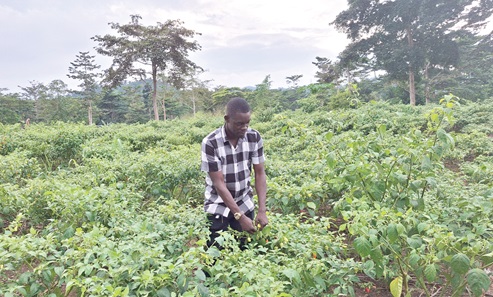Ghana has so far received $21.8 million in carbon payments from the World Bank for implementing programmes that helped to reduce emissions by 4,351,626 tonnes of carbon dioxide equivalent (tCO2e).
The amount covered carbon payments for the 2019 to 2021 monitoring years under the Ghana Cocoa Forest REDD+ Programme (GCFRP), an emission reduction programme implemented across the country’s cocoa forest landscape as an incentive for small-holder farmers to adopt sound agronomic practices for climate resilience.
Statistics made available to the Daily Graphic by the Climate Change Unit of the Forestry Commission showed that in 2023, the country received $4.9 million for 972,465 tCO2e for the 2019 monitoring year, while $16.9 million was received in 2024 for 3,378,161 tCO2e covering the 2021 and 2022 monitoring years.
Additionally, the figures showed that there was an outstanding amount of $29 million payment covering benefits for carbon reduction from 2022 to 2024.
A further delve into the records revealed that more than $13.9 million of that amount was disbursed to 560,808 cocoa farmers across six hotspot intervention areas (HIAs) in the country’s cocoa forest landscape.
A breakdown of the figures showed that the Asunafo Asutifi HIA received in excess of $5 million; Juaboso-Bia received $3.6 million; while the Kakum HIA got $1.6 million.
Also, the Ahafo HIA had over $1.3 million; Sefwi Wiawso-Bibiani got $1.3 million; while Atewa received about $1.1 million.
The statistics also showed that there was an outstanding amount of over $28.2 million to be paid by the World Bank for the 2022 to 2024 monitoring years.
Context
The implementation of the GCFRP started in 2019 as part of measures to address the drivers of deforestation and forest degradation.
The programme was rolled out against the backdrop of increasing depletion of the forests and the ripple effects on cocoa production, the country’s leading foreign exchange earner.
It is on three key objectives – reducing expansionist cocoa production activities in forest areas; cutting down emissions by about 40 per cent within the 20-year lifespan of the strategy (2016-2035), and improving the livelihoods of cocoa farmers.
The reward-based programme offers carbon credit payments from the global carbon fund when the hotspot intervention areas yield results.
Per the agreement signed with the World Bank’s Carbon Fund, the hotspot intervention areas are to reduce emissions by 10 million tonnes by 2024 (2019-2024) with a unit yield of $5, translating into $50 million.
To ensure effective implementation of the programme, the National REDD+ Secretariat of the Forestry Commission and COCOBOD, with support from the chocolate industry and companies along the value chain, identified what is called HIA.
The six intervention areas are selected based on the intensity of the drivers of deforestation and forest degradation, existing projects and interventions being implemented by the private sector and state actors, adequate capacity and implementation structures at the field level.
Those selected under the GCFRP are the Sefwi Wiawso/ Bibiani HIA, located in the Western North Region of Ghana; the Juaboso-Bia HIA, located in the Western North Region in the Juaboso and Bia districts, and the Kakum HIA, located in the Central Region of Ghana.
The rest are Asutifi/Asunafo HIA, located in the Asunafo and Asutifi districts in the Ahafo Region, Atewa in the Eastern Region, which lies within the Atewa, Denkyembour and East Akim districts, and the Ahafo-Ano intervention area, located in the Ahafo-Ano South, Atwima Mponua and Atwima Nwabiagya districts in the Ashanti Region.
Benefits sharing
During a recent field trip to the Atewa HIA on October 14, the Benefit Sharing Officer at the Climate Change Unit of the Forest Commission, Ivy Ashiley, told the Daily Graphic that 39 per cent of the $21.8 million that the country received as carbon payments went to relevant government institutions, including the Forestry Commission, Ghana Cocoa Board (COCOBOD), and the metropolitan, municipal and district assemblies (MMDAs).
She explained that the amount that went to the local communities was channelled into community projects and the purchase of climate inputs.
Apart from the direct payment of carbon credits to the local communities, Ms Ashiley said there was an alternative livelihood component, which helped farmers to have sustainable sources of income when the cocoa season was out.

